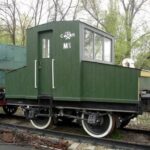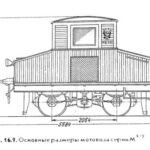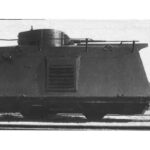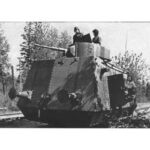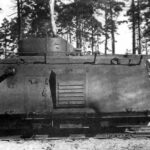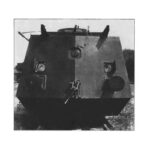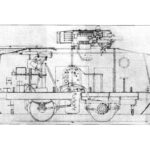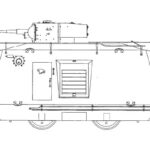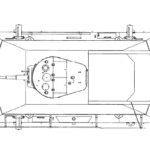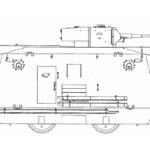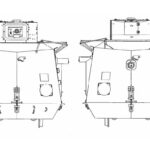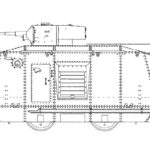Heavy Armored Railcar Model is here
In the early 1930s, Russian military strategists sought an alternative to the massive armored trains engaged during the First World War and civil war. Since a train is by definition heavy, slow to implement and vulnerable as it is forced to move on a fixed lane, it was necessary to create lighter vehicles for lane recognition (typically 5 to 10 km upstream of the train) and transmissions. These vehicles were often armored cars (FAI, BA20, BA6 and BA10) transformed for rail use. The increase in performance of petrol engines made possible the motorization of armored vehicles on rail which without reaching the possibility of towing an entire armored train allowed at least to consider the manufacture of more or less imposing railcars and superiors to armored cars. The advantages of the railways were numerous:
discretion because no more emission of a big plume of coal smoke
the speed often higher (75km / h for the BDT-35 against about 50km / h for an armored train)
the greater autonomy (250km for the BDT-35 against about 100km for an armored train)
The maintenance of a truck engine had nothing to do with the maintenance of a boiler on an armored train
The idea was that in the event of success of this type of equipment, it would gradually supplant the old, less discreet and much heavier armored trains. Various shipyards in the USSR were given the task of developing these machines (Lugansk and Orsk for the MBV-D2 of the NKVD, Moscow for the BDT-35 series, DSh and DTR, Leningrad for the MBV-2 project).
As for the BDT-35, DSh and DTR, it was the production in 1933 of the Mz locomotive by the kaluga factory that supplied the chassis in combination with the 73CV engine of the Zis5 truck.
The specifications were drawn up in 1934 and provided for three types of vehicles: a heavy model (cannon), a transport model and a staff model.
As for the heavy model, a production order was immediately made with the Mozherez factory in Moscow. The prototype was ready by the end of 1934 and received the name of E (experimental) -7. The prototype was then assigned to the Red Army under the designation BDT (heavy armored car) -35 (year of receipt). Tests were successfully carried out on the Bryansk-Smolensk line from November 30th, 1935 to March 26th, 1936, the draisine covered 1060 km.
The Podolsk factory was then chosen for mass production because it had the experience of producing the T-27 and T-37 bodies. The initial ordering of ten vehicles posed numerous problems, including the supply of spare parts, including turrets, by the subcontractors, which made it possible to build only two copies at the end of 1936. In total, the factory will only supply five BDT-35 (note that these are riveted vehicles, the only welded plate vehicle comes from the Mozherez factory). Note that it will also provide only five DTRs and one DSh.
In the mid-1930s, the Red Army Staff decided to assign the BDT-35 to the Siberian rail network. Indeed, in this wilderness, only this one could be used all the year and was able to connect effectively the different vital points. The advantages of railways on armored trains, especially in terms of maintenance in a region where infrastructures were scarce, made them indispensable.
On May 28th, 1936, an order was given to form a special battalion of railcars for deployment in the eastern parts of the country. Its composition was 10 BDT-35, one DSh, 21 armored cars BA3-zh (railroad), 9 armored cars FAI-zhd (railroad), and other vehicles. In total, the battalion comprised 268 personnel.
The battalion was formed on August 15, 1936 but with the only one BDT-35 available.
In July 1937, it was renamed the 5th Special Battalion of armored railcars (5 ° obdr), and transferred in September to the Khabarovsk region (Bureya station). His new staffing was 4 BDT-35s, one DSh, and 39 armored cars.
This unit spent the entire war in eastern Russia without fighting until the August 1945 offensive in Manchuria against the Japanese Army and the Kwantung. It was this battalion that accompanied and secured the staff of the 2nd Army during the surrender talks in the city of Sun-Wu.
On November 2, 1945, an order was given to suppress the battalion and to transfer the vehicles to the depots. This marks the end of the BDT-35 history.
Characteristics :
Length: 7,075m / Width: 2,868m / Height: 3,29m
Weight: 19t
Armor: sides: 16mm / bevelled part: 10mm / roof and floor: 8mm
Weapons: This railcar was formidable with a 45mm gun (154 rounds), three maxim machine guns (21000 rounds) two DT machine guns (1536 rounds), a double carriage of Maxim machine guns in the box firing upwards. Note the originality of the sliding roof to the rear that allowed the double lcarriage of Maxim to engage aircraft.
Engine: Zis-5 of 73 HP / consumption: 24l / 100km
Crew: 9 men
Radio: 71-TK1 shortwave station which allowed connections on 40km in fixed position and 10 to 30 km in motion.
Note that this vehicle also had a special device that allowed it to turn around to change lanes like many railcars.


